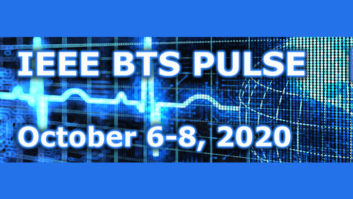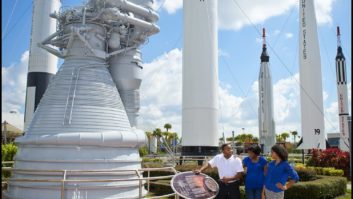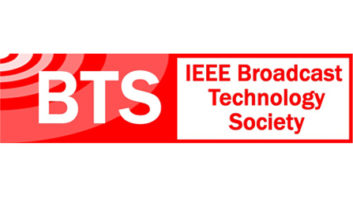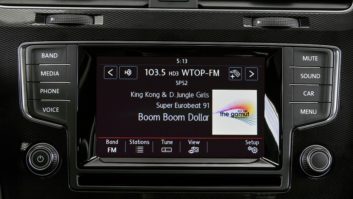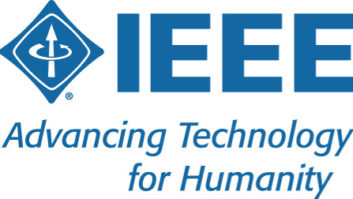IBOC issues, audio advances, cybersecurity, grounding and bonding, broadcast antenna evolution and space exploration were highlights of the annual IEEE Broadcast Technology Society Fall Symposium. It was the 63rd such gathering of radio and TV engineering personnel in as many years. The October event was held at the Caribe Royale hotel in Orlando, Fla. and attracted some 120 participants from across the United States and beyond.
More than 30 technical presentations were offered at this year’s conference.

A group of conference registrants enjoyed a behind-the-scenes tour of the Kennedy Space Center. Here the group poses beneath the engine nozzles of the enormous Saturn 5 rocket on display.
Credit: Photos by James O’NealFIRST ITEM OF BUSINESS
FM IBOC was at the top of the list at the conference, with a kick-off session on Wednesday featuring presentations by Nautel’s Philipp Schmid and Dielectric’s John Schadler.
Schmid touted the potential advantages of interleaving HD Radio signals, including operating economy and many more program selections for the listener. Schadler offered suggestions and techniques for accommodating RF power increases at combined IBOC FM transmission sites.
The NAB’s David Layer continued the radio theme with an in-depth look at operations of NAB Labs, which began operations about three years ago. GeoBroadcast Solutions’ Hal Kneller followed with a presentation on the implementation of a single-frequency network at Florida’s WSUN.
The often-neglected topic of connecting a broadcast facility to the earth was explored by ERI’s President/CEO Tom Silliman in his presentation “Grounding Concepts and Techniques for Broadcast.” He described effective grounding methodologies as well as the measurement of the effectiveness of grounding systems.
Other symposium presentations included a session on AES67 with industry experts Greg Shay of the Telos Alliance, Phil Owens of Wheatstone, Keyur Parikh of GatesAir and Al Salci of SAS. They presented information individually about the audio-over-IP interoperability standard and later joined in a panel discussion on the topic.
CYBER [IN]SECURITY
As broadcasters become more and more dependent on the Internet, protection of data and content has become more and more of an issue.
The 2015 symposium addressed this with two presentations on cybersecurity. Information technology specialist George Waters offered his views on safeguarding data in “Cybersecurity Risk Management and Best Practices,” and during the conference’s Wednesday lunch break, keynote speaker Frank Artes provided a rather alarming wakeup call by extracting data from smartphones and laptop computers in use by symposium attendees during his presentation.
Artes displayed the MAC addresses and other information gleaned from the wireless devices via a large-screen projector, describing just how easy it was a hacker to steal data in this fashion.
“Your blind faith in security products will not end well,” said Artes. “Turn off radios you are not using, remove SSIDs you no longer use and pay attention to the SSID your device is connected to.”
ROAD TRIP TO THE CAPE
Through 2012, the BTS Symposium had been held in Washington. A decision was made to move it around the country to make it more accessible to the broadcast engineering community.
With this year’s event being held in Orlando, a special treat was available to 25 lucky registrants in the form of a pre-conference trip to the Kennedy Space Center, located about an hour’s drive from the city. The guests were given a behind-the-scenes tour of NASA facilities and were later hosted at a dinner party at a nearby events center.
A space “theme” continued on Thursday with a luncheon keynote address by long-time NASA project manager and space evangelist Jon Cowart, who had served as a tour guide at the Kennedy Center. In his presentation, Cowart said many space exploration projects have benefitted society on one way or another.
He described the reception of radio signals from two NASA deep space probes that are now more than 10 “light hours” away from earth.
“You folks will appreciate this,” said Cowart. “They [the probes] are a long way away. If you took the total amount of radio energy we get from the Voyager probes in a year and bundle it up into one nice neat little package of energy, it’s one one-thousandth of the energy from a snowflake hitting the ground. And yet we can still communicate.”
FROM MARCONI TO DIGITAL BROADCASTING
Another luncheon speaker, longtime consulting engineer Ron Rackley of duTreil, Lundin & Rackley, drew applause with his narrative of the broadcast antenna’s evolution, tracing it from Marconi’s first attempt to get a lot of wire high up in the air and on to the antennas use in 21st century communications. As part of his presentation, Rackley offered a “litmus test” for radio engineers.
“You know you might be a radio engineer if as a child you enjoyed listening to the kilocycles and kilowatts information at station signoff right before the national anthem was played, or if you would beg your mother to drive you by a transmitter site so you could look at the towers in the field,” said Rackley.
The 2016 BTS Symposium moves to Hartford, Conn., with the Hartford Marriott Hotel hosting the Oct. 12–14 event. Event information will be posted at http://bts.ieee.org/broadcastsymposium.





